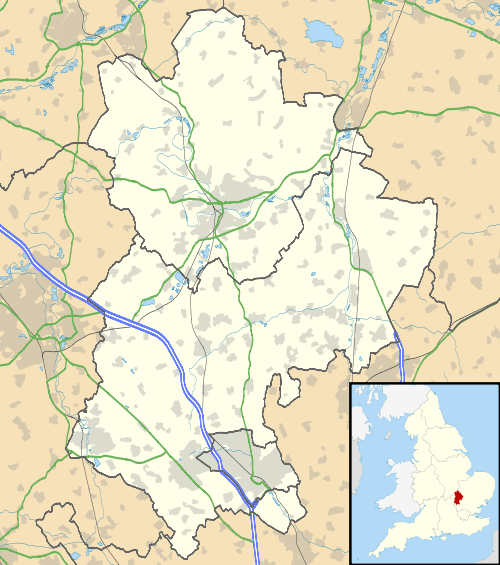Cockayne Hatley
| Cockayne Hatley | |
|---|---|
|
The far end of the village | |
 Cockayne Hatley Cockayne Hatley shown within Bedfordshire | |
| Population | 75 |
| OS grid reference | TL260496 |
| Civil parish | |
| Unitary authority | |
| Ceremonial county | |
| Region | |
| Country | England |
| Sovereign state | United Kingdom |
| Post town | Sandy |
| Postcode district | SG19 |
| Dialling code | 01767 |
| Police | Bedfordshire |
| Fire | Bedfordshire and Luton |
| Ambulance | East of England |
| EU Parliament | East of England |
Cockayne Hatley is a small village in Bedfordshire dating back to Saxon times (population 2007 approximately 75 with 33 houses), bordering on Cambridgeshire, 3 miles (5 km) east of Potton, 6 miles (10 km) north-east from Biggleswade and 9 miles (15 km) south-east from St. Neots. The village's population in 1891 was 104. It is in the civil parish of Wrestlingworth and Cockayne Hatley.
The soil is strong clay with clay subsoil. The chief crops are wheat, oil seed rape, beans and peas. The farmland surrounding the village covers an area of 587 hectares and belongs to a Danish family. The farmland is contract farmed for the family by W.J Kendall & sons, based in Eyeworth, run by Peter Kendall, the former president of the National Farmers' Union, and his brother Richard.
Cockayne Hatley Hall
Cockayne Hatley Hall, once known as Cockayne Hatley Mansion, was originally established by Sir John Cockayne in the 15th century. The Hall has been added to and rebuilt many times. The main parts of the present building are early Victorian with the East wing dating back to the reign of George I. There is still a single wall and fireplace dating back to Tudor times.
The Cockayne family continued to reside at the Hall until the late 1860s. Several families took on the Hall and the Estate until 1929 when Mr John Whitehead purchased the estate and eventually established the largest apple orchard in England with over one million Cox's Orange Pippin trees, until they were dug up and burned as uneconomic in 1974.[1]
A fire destroyed much of the south facing building in 1931. Although repaired, many of the grand rooms and architecture were lost. Mr Whitehead left the Hall shortly after the war selling the whole estate to the Co-op Farming group. Much of the property subsequently fell into disrepair before the Hall, together with some of the surrounding land, was sold back to private ownership. Now greatly restored, the Hall and the adjacent Church of John the Baptist reflect the affluence of its history.
From 1894 to 1897 the Hall was rented by part of the "Old Family Line", the Duke of Rutland. His daughter, Lady Diana Manners, lived there as a young girl before going on to earn the widespread reputation as the most beautiful young woman in England, and appeared in countless profiles, photographs and articles in newspapers and magazines including the front page of Time magazine in February 1926.
St John's Church
The Church of St John the Baptist is situated at the gates of an ancient hall and dates to the thirteenth century. It contains numerous high quality works of carved wood and stained glass, mostly from the abbey of Alne near Charleroi.[2] Dating from 1689, these works were "liberated" from Flanders following the Napoleonic wars[2] by the Rev. Henry Cockayne Cust, parish rector from 1806 to 1861.
The churchyard contains a handsome monument over the grave of the poet W. E. Henley, who was a frequent visitor to Cockayne Hatley Hall. Henley, who had a wooden leg, was Robert Louis Stevenson's model for Long John Silver. Henley was also a friend of J. M. Barrie, the author of Peter Pan. Henley used to address Barrie as "friend", which Henley's only daughter, Margaret (1888–1894), who is also buried there along with her parents, mispronounced as "fwend" and changed in a childish way to "fwendy-wendy".[3][4] The latter part of this familiar name gave the name of "Wendy Darling" which later became the Wendy of Peter Pan. Henley is now chiefly remembered as the author of the poem "Invictus".
References
- ↑ "Cockayne Hatley Crops". Archived from the original on 17 June 2011. Retrieved 7 January 2009.
- 1 2

- ↑ "The History of Wendy". Archived from the original on 18 March 2009. Retrieved 25 July 2009.
- ↑ Winn, Christopher. I Never Knew That About England.